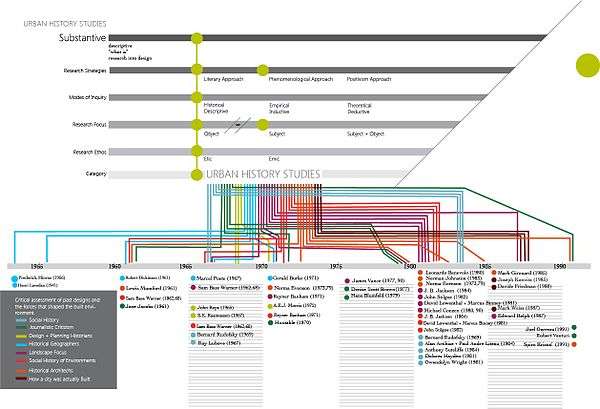Urbanism
Urbanism is the study of how inhabitants of urban areas, such as towns and cities, interact with the built environment. It is a direct component of disciplines such as urban planning, which is the profession focusing on the physical design and management of urban structures and urban sociology which is the academic field the study of urban life and culture.
Many architects, planners, geographers, and sociologists investigate the way people live in densely populated urban areas. There is a wide variety of different theories and approaches to the study of urbanism.[1] However, in some contexts internationally, urbanism is synonymous with urban planning, and urbanist refers to an urban planner.
The term urbanism originated in the late nineteenth century with the Spanish engineer-architect Ildefons Cerda, whose intent was to create an autonomous activity focused on the spatial organization of the city.[2] Urbanism's emergence in the early 20th century was associated with the rise of centralized manufacturing, mixed-use neighborhoods, social organizations and networks, and what has been described as "the convergence between political, social and economic citizenship".[3]
Urbanism can be understood as placemaking and the creation of place identity at a citywide level, however as early as 1938 Louis Wirth wrote that it is necessary to stop 'identify[ing] urbanism with the physical entity of the city', go 'beyond an arbitrary boundary line' and consider how 'technological developments in transportation and communication have enormously extended the urban mode of living beyond the confines of the city itself.' [4]
Concepts

Network-based theories
Gabriel Dupuy applied network theory to the field of urbanism and suggests that the single dominant characteristic of modern urbanism is its networked character, as opposed to segregated conceptions of space (i.e. zones, boundaries and edges).[5]
Stephen Graham and Simon Marvin argue that we are witnessing a post-urban environment where decentralized, loosely connected neighborhoods and zones of activity assume the former organizing role played by urban spaces. Their theory of splintering urbanism involves the "fragmentation of the social and material fabric of cities" into "cellular clusters of globally connected high-service enclaves and network ghettos" driven by electronic networks that segregate as much as they connect. Dominique Lorrain argues that the process of splintering urbanism began towards the end of the 20th century with the emergence of the gigacity, a new form of a networked city characterised by three-dimensional size, network density and the blurring of city boundaries.[6]
Manuel Castells suggested that within a network society, "premium" infrastructure networks (high-speed telecommunications, ‘smart’ highways, global airline networks) selectively connect together the most favored users and places and bypass the less favored.[6] Graham and Marvin argue that attention to infrastructure networks is reactive to crises or collapse, rather than sustained and systematic, because of a failure to understand the links between urban life and urban infrastructure networks.
Other modern theorists
Douglas Kelbaugh identifies three paradigms within urbanism: New Urbanism, Everyday Urbanism, and Post-Urbanism.[7]
Paul L. Knox refers to one of many trends in contemporary urbanism as the "aestheticization of everyday life".[8]
Alex Krieger states that urban design is less a technical discipline than a mind-set based on a commitment to cities.[9]
See also
- Ecological urbanism extends on concepts of Landscape urbanism
- Green urbanism
- Landscape urbanism, an urbanism where cities are seen though the lens of landscape architecture and ecology
- New urbanism, a response to contemporary problems such as urban sprawl and traffic congestion
- Feminist Urbanism
- Latinx urbanism
- Unitary urbanism, a critique of urbanism as a technology of power by the situationists
- Sustainable Urbanism
- Urban economics, the application of economic models and tools to analyse the urban issues such as crime, house and public transit
- Urban geography
- Urban design
- Urban planning
- Principles of Intelligent Urbanism
- Urbanate, a living environment envisioned by the Technocracy movement
- World Urbanism Day
Endnotes
- Jonathan Barnett, “A Short Guide to 60 of the Newest Urbanisms,” Planning, volume 77 (2011-4), pp. 19–21
- Caves, R. W. (2004). Encyclopedia of the City. Routledge. p. 734. ISBN 978-0415862875.
- Blokland-Potters, Talja, and Savage, Mike (2008). Networked Urbanism: Social Capital in the City. Ashgate Publishing.
- Wirth, Louis (1938). Urbanism as a Way of Life. The American Journal of Sociology, volume 44, number 1: pp. 1–24. July.
- Dupuy, Gabriel (2008). Urban Networks – Network Urbanism. Amsterdam: Techne Press.
- Graham, Stephen, and Marvin, Simon (2001). Splintering Urbanism: Networked Infrastructures, Technological Mobilities and the Urban Condition. London: Routledge.
- Kelbaugh, Douglas (2009), Three Urbanisms and the Public Realm
- Knox, Paul (2010). Cities and Design, p. 10.
- Krieger, Alex (2009). Urban Design, p. 113.
